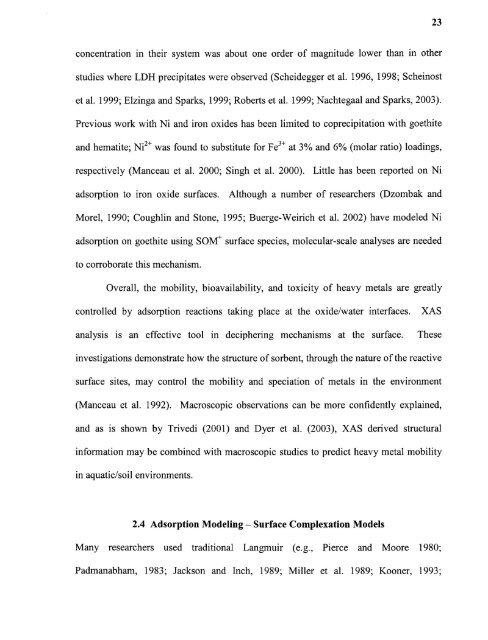Heavy metal adsorption on iron oxide and iron oxide-coated silica ...
Heavy metal adsorption on iron oxide and iron oxide-coated silica ...
Heavy metal adsorption on iron oxide and iron oxide-coated silica ...
Create successful ePaper yourself
Turn your PDF publications into a flip-book with our unique Google optimized e-Paper software.
23c<strong>on</strong>centrati<strong>on</strong> in their system was about <strong>on</strong>e order of magnitude lower than in otherstudies where LDH precipitates were observed (Scheidegger et al. 1996, 1998; Scheinostet al. 1999; Elzinga <strong>and</strong> Sparks, 1999; Roberts et al. 1999; Nachtegaal <strong>and</strong> Sparks, 2003).Previous work with Ni <strong>and</strong> ir<strong>on</strong> <strong>oxide</strong>s has been limited to coprecipitati<strong>on</strong> with goethite<strong>and</strong> hematite; Ni 2+ was found to substitute for Fe 3+ at 3% <strong>and</strong> 6% (molar ratio) loadings,respectively (Manceau et al. 2000; Singh et al. 2000). Little has been reported <strong>on</strong> Ni<str<strong>on</strong>g>adsorpti<strong>on</strong></str<strong>on</strong>g> to ir<strong>on</strong> <strong>oxide</strong> surfaces. Although a number of researchers (Dzombak <strong>and</strong>Morel, 1990; Coughlin <strong>and</strong> St<strong>on</strong>e, 1995; Buerge-Weirich et al. 2002) have modeled Ni<str<strong>on</strong>g>adsorpti<strong>on</strong></str<strong>on</strong>g> <strong>on</strong> goethite using SOM+ surface species, molecular-scale analyses are neededto corroborate this mechanism.Overall, the mobility, bioavailability, <strong>and</strong> toxicity of heavy <str<strong>on</strong>g>metal</str<strong>on</strong>g>s are greatlyc<strong>on</strong>trolled by <str<strong>on</strong>g>adsorpti<strong>on</strong></str<strong>on</strong>g> reacti<strong>on</strong>s taking place at the <strong>oxide</strong>/water interfaces. XASanalysis is an effective tool in deciphering mechanisms at the surface. Theseinvestigati<strong>on</strong>s dem<strong>on</strong>strate how the structure of sorbent, through the nature of the reactivesurface sites, may c<strong>on</strong>trol the mobility <strong>and</strong> speciati<strong>on</strong> of <str<strong>on</strong>g>metal</str<strong>on</strong>g>s in the envir<strong>on</strong>ment(Manceau et al. 1992). Macroscopic observati<strong>on</strong>s can be more c<strong>on</strong>fidently explained,<strong>and</strong> as is shown by Trivedi (2001) <strong>and</strong> Dyer et al. (2003), XAS derived structuralinformati<strong>on</strong> may be combined with macroscopic studies to predict heavy <str<strong>on</strong>g>metal</str<strong>on</strong>g> mobilityin aquatic/soil envir<strong>on</strong>ments.2.4 Adsorpti<strong>on</strong> Modeling — Surface Complexati<strong>on</strong> ModelsMany researchers used traditi<strong>on</strong>al Langmuir (e.g., Pierce <strong>and</strong> Moore 1980;Padmanabham, 1983; Jacks<strong>on</strong> <strong>and</strong> Inch, 1989; Miller et al. 1989; Ko<strong>on</strong>er, 1993;
















